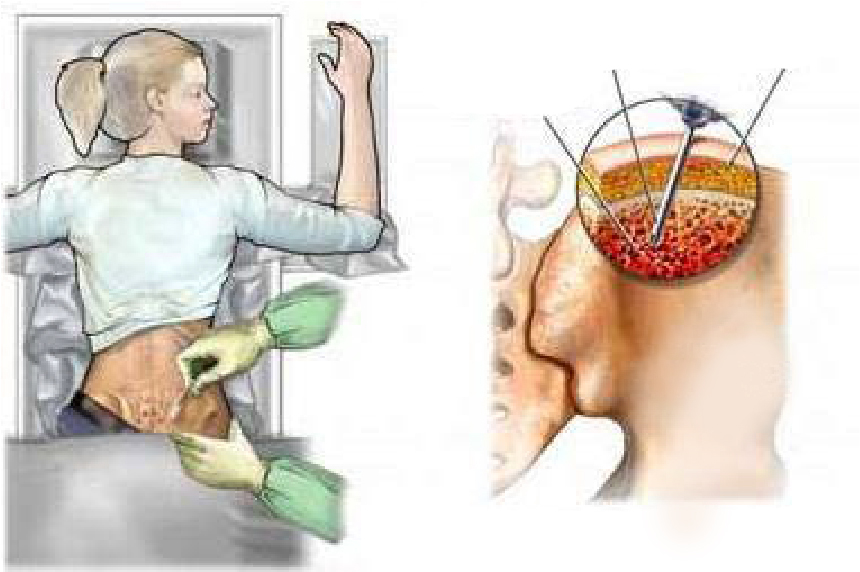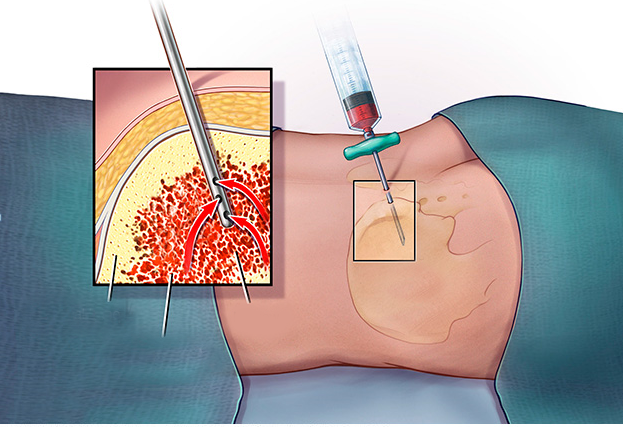WHAT ARE BONE MARROW ASPIRATION AND BIOPSY?

Bone marrow biopsy and bone marrow aspiration are procedures to collect and examine bone marrow — the spongy tissue inside some of your larger bones. The marrow is where you make red blood cells, white blood cells, and platelets from cells called “stem cells”.
Bone marrow biopsy and aspiration can show whether your bone marrow is healthy and making normal amounts of blood cells. Doctors use these procedures to diagnose and monitor blood and marrow diseases, including some cancers, as well as fevers of unknown origin.
Bone marrow has a fluid portion and a more solid portion. In bone marrow biopsy, your doctor uses a needle to withdraw a sample of the solid portion. In bone marrow aspiration, a needle is used to withdraw a sample of the fluid portion.
A bone marrow biopsy and a bone marrow aspiration offer different, but complementary, information about your bone marrow cells. The two procedures are usually performed together.
WHY IS IT DONE?
Bone marrow biopsy and bone marrow aspiration offer detailed information about the condition of your bone marrow and blood cells.
Your doctor may perform a bone marrow exam to:
- Diagnose a disease or condition involving the bone marrow or blood cells;
- Determine the stage or progression of a disease;
- Monitor the treatment of a disease.
Bone marrow biopsy and aspiration may be used for many conditions. These include:
- Blood cell conditions in which too few or too many of certain types of blood cells are produced, such as anaemia, leukopenia, leukocytosis, thrombocytopenia, thrombocytosis, pancytopenia and polycythaemia;
- Cancers of the blood or bone marrow, including leukaemias, lymphomas and multiple myeloma;
- Cancers that have spread from another area, such as breast, into the bone marrow;
- Haemochromatosis;
- Fevers of unknown origin.
HOW YOU PREPARE
Bone marrow exams are often performed on an outpatient basis. Special preparation usually isn’t needed. However, you may want to:
- Tell your doctor about medications and supplements you take. Certain medications and supplements may increase your risk of bleeding after a bone marrow biopsy and aspiration;
- Tell your doctor if you’re nervous about your procedure. Discuss your worries about the exam with your doctor. In some cases, your doctor may give you a sedative medication before your exam, in addition to a numbing agent (local anaesthesia) at the site where the needle is inserted.
WHAT YOU CAN EXPECT
The procedure can be done in the consultation room or in the bedroom for hospitalised patients.
Most people need only local anaesthesia, as bone marrow exam can cause brief, but sharp, pain. You’ll be fully awake during the procedure, but the aspiration and biopsy site will be numbed to reduce pain. If you feel anxious about pain, you may be given an intravenous medication so that you’re either completely or partially sedated during the bone marrow exam.
The bone marrow exam typically takes about 10 minutes. Extra time is needed for preparation and post-procedure care, especially if you receive intravenous sedation.
BONE MARROW ASPIRATION
The bone marrow fluid is usually collected from the top ridge of the back of a hipbone (posterior iliac crest). Sometimes, the front of the hip may be used. Occasionally it is collected from the breastbone (sternum) or, in children under the age of 18 months, from the lower leg bone.
You’ll be asked to lie on your abdomen or side (or on your back if procedure is done with the sternum), and your body will be draped with cloth so that only the exam site is showing. The area where the doctor will insert the biopsy needle is marked and cleaned. The area where the sample will be taken will be “numbed” with lidocaine.
The doctor will make a small incision then insert a hollow needle through the bone and into the bone marrow. Using a syringe attached to the needle, the doctor will withdraw a sample of the liquid portion of the bone marrow. You may feel a brief sharp pain or stinging. The aspiration takes only a few minutes. Several samples may be taken.
The health care team will check the sample to make sure it is adequate. Rarely, fluid cannot be withdrawn and the needle is moved for another attempt.
BONE MARROW BIOPSY
The bone marrow tissue sample (biopsy) is usually collected from the top ridge of the back of a hipbone (posterior iliac crest). Sometimes, the front of the hip may be used.

Your doctor will use a larger needle to withdraw a sample of solid bone marrow tissue. The biopsy needle is specially designed to collect a core (cylindrical sample) of bone marrow. Your doctor will rotate the needle until a sample of tissue is removed. You may feel pain and pressure as the needle moves into the bone. Your doctor will then remove the entire needle and place a pressure covering over the site to prevent bleeding.
- Cortical bone
- Spongy bone
- Marrow
- Pelvis
After the procedure
Pressure will be applied to the area where the needle was inserted to stop the bleeding. Then a bandage will be placed on the site.
If you had local anaesthesia, you will be asked to lie on your back for 10 to 15 minutes and apply pressure to the biopsy site. You can then leave and go about your day, returning to normal activity as soon as you feel up to it.
If you had intravenous sedation, you will be taken to a recovery area. Plan to have someone drive you home, and take it easy for 24 hours.
You may feel some tenderness for a week or more after your bone marrow exam. Ask your doctor about taking a pain reliever.
Site care
Wear the bandage and keep it dry for 24 hours. Don’t shower, bathe, swim or use a hot tub. After 24 hours you can get the aspiration and biopsy area wet.
Contact your doctor if you have:
- Bleeding that soaks through the bandage or doesn’t stop with direct pressure;
- A persistent fever;
- Worsening pain or discomfort;
- Swelling at the procedure site;
- Increasing redness or drainage at the procedure site.
To help minimise bleeding and discomfort, avoid rigorous activity or exercise for a day or two.
If bleeding occurs after your procedure, apply pressure to the area.
RESULTS
The bone marrow samples are sent to a laboratory for analysis. Your doctor generally gives you the results within a few days, but it may take longer.
At the lab, a haematologist or a specialist in analysing biopsies (pathologist) will evaluate the samples to determine if your bone marrow is making enough healthy blood cells and to look for abnormal cells. The information can help your doctor:
- Confirm or rule out a diagnosis;
- Determine how advanced a disease is;
- Evaluate whether treatment is working.
Depending on your exam results, you may need follow-up tests.



